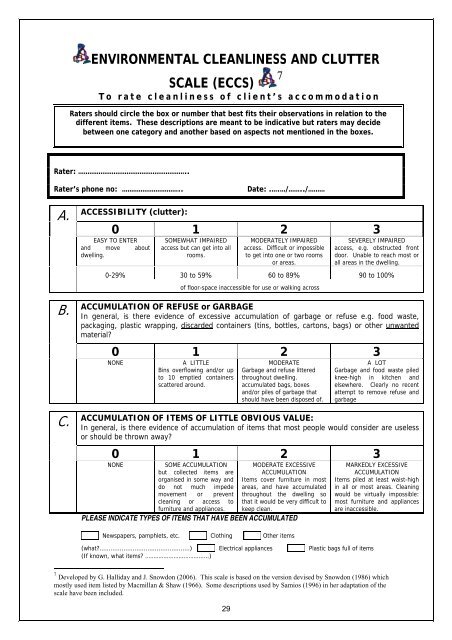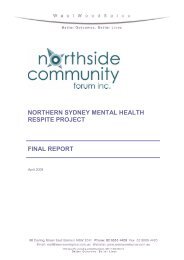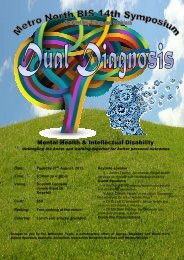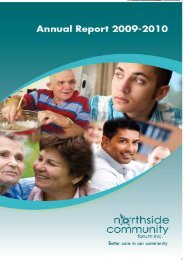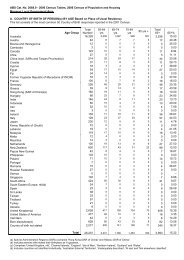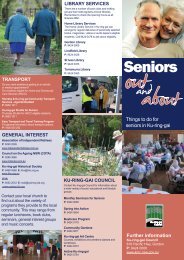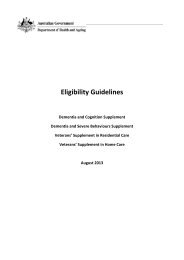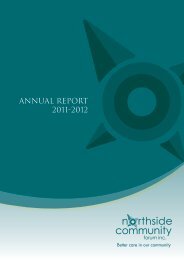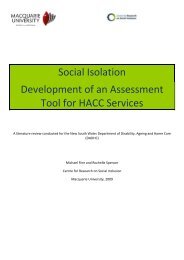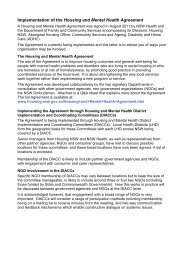Guidelines for field staff to assist people living in ... - Housing NSW
Guidelines for field staff to assist people living in ... - Housing NSW
Guidelines for field staff to assist people living in ... - Housing NSW
You also want an ePaper? Increase the reach of your titles
YUMPU automatically turns print PDFs into web optimized ePapers that Google loves.
ENVIRONMENTAL CLEANLINESS AND CLUTTERSCALE (ECCS)To rate cleanl<strong>in</strong>ess of client’s accommodationRaters should circle the box or number that best fits their observations <strong>in</strong> relation <strong>to</strong> thedifferent items. These descriptions are meant <strong>to</strong> be <strong>in</strong>dicative but raters may decidebetween one category and another based on aspects not mentioned <strong>in</strong> the boxes.7Rater: …………………………………………………..Rater’s phone no: …………………………..Date: .….…/……../………A.B.C.ACCESSIBILITY (clutter):0 1 2 3EASY TO ENTERand move aboutdwell<strong>in</strong>g.SOMEWHAT IMPAIREDaccess but can get <strong>in</strong><strong>to</strong> allrooms.MODERATELY IMPAIREDaccess. Difficult or impossible<strong>to</strong> get <strong>in</strong><strong>to</strong> one or two roomsor areas.SEVERELY IMPAIREDaccess, e.g. obstructed frontdoor. Unable <strong>to</strong> reach most orall areas <strong>in</strong> the dwell<strong>in</strong>g.0-29% 30 <strong>to</strong> 59% 60 <strong>to</strong> 89% 90 <strong>to</strong> 100%of floor-space <strong>in</strong>accessible <strong>for</strong> use or walk<strong>in</strong>g acrossACCUMULATION OF REFUSE or GARBAGEIn general, is there evidence of excessive accumulation of garbage or refuse e.g. food waste,packag<strong>in</strong>g, plastic wrapp<strong>in</strong>g, discarded conta<strong>in</strong>ers (t<strong>in</strong>s, bottles, car<strong>to</strong>ns, bags) or other unwantedmaterial?0 1 2 3NONEA LITTLEB<strong>in</strong>s overflow<strong>in</strong>g and/or up<strong>to</strong> 10 emptied conta<strong>in</strong>ersscattered around.MODERATEGarbage and refuse litteredthroughout dwell<strong>in</strong>g.accumulated bags, boxesand/or piles of garbage thatshould have been disposed of.A LOTGarbage and food waste piledknee-high <strong>in</strong> kitchen andelsewhere. Clearly no recentattempt <strong>to</strong> remove refuse andgarbageACCUMULATION OF ITEMS OF LITTLE OBVIOUS VALUE:In general, is there evidence of accumulation of items that most <strong>people</strong> would consider are uselessor should be thrown away?0 1 2 3NONESOME ACCUMULATIONbut collected items areorganised <strong>in</strong> some way anddo not much impedemovement or preventclean<strong>in</strong>g or access <strong>to</strong>furniture and appliances.MODERATE EXCESSIVEACCUMULATIONItems cover furniture <strong>in</strong> mostareas, and have accumulatedthroughout the dwell<strong>in</strong>g sothat it would be very difficult <strong>to</strong>keep clean.PLEASE INDICATE TYPES OF ITEMS THAT HAVE BEEN ACCUMULATEDMARKEDLY EXCESSIVEACCUMULATIONItems piled at least waist-high<strong>in</strong> all or most areas. Clean<strong>in</strong>gwould be virtually impossible:most furniture and appliancesare <strong>in</strong>accessible.Newspapers, pamphlets, etc. Cloth<strong>in</strong>g Other items(what?.................................................) Electrical appliances Plastic bags full of items(If known, what items? ………….……….……….…..)7 Developed by G. Halliday and J. Snowdon (2006). This scale is based on the version devised by Snowdon (1986) whichmostly used item listed by Macmillan & Shaw (1966). Some descriptions used by Samios (1996) <strong>in</strong> her adaptation of thescale have been <strong>in</strong>cluded.29


